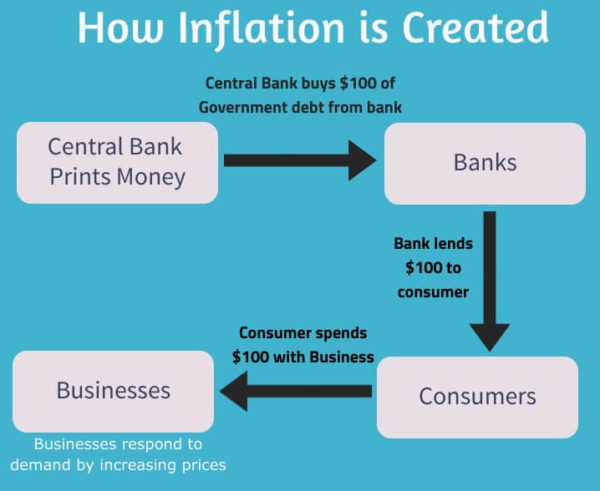What is Inflation
Inflation Definition
Inflation is where the price of goods increases over a set period of time. In other words, the price of a good or service is increasing.
Inflation is generally measured using what is known as the Consumer Price Index (CPI), which tracks the prices of a basket of commonly purchased goods. When the price of these goods increases on average, we see what is known commonly as inflation. In other words, the prices of some goods may fall, but the majority of goods are increasing in price, leading to inflation on the whole.
Key Points
- Inflation is where prices in the economy start to increase.
- Inflation is measured using the consumer price index.
- Prolonged periods of high inflation can damage the economy as it becomes skewed away from investment and instead towards consumption.
The Role of the Central Bank
Most Central Banks aim for an inflation rate of around 2 percent. This is so that consumers always expect prices to increase, thereby encouraging consumers to move their purchasing decisions forward and incentivising further consumption. As consumers expect higher prices next year, they buy now in order to get goods at a cheap price. In turn, this helps to stimulate employment and the wider economy.
This also requires a high velocity of money. When money changes hands quickly, it means A is demanding a product from B and they are demanding a product from C, who is then demanding a product from D. If A demands a product from B, but they do not demand anything from C, then that money is stagnant. If B is no longer demanding a product from C, then C has less income. They are then unable to buy from D, so on and so forth.
So the Central Banks want to ensure that B still buys from C. This is so that economic activity is not reduced, thereby impacting upon employment.
The Central Bank cannot force B to spend their money with C. So they have to use other means to try and encourage velocity to increase. The main tool in their armour is interest rates.
What Causes Inflation
As the late Milton Friedman said; ‘Inflation is and will always be a monetary phenomenon.’ By this, he meant that inflation can only be created by Central Banks creating money from thin air. The Central Bank sends the water to the pipes, and banks are the ones who release the tap. Without the Central Bank sending more water, the banks cannot create further inflation.
Milton Friedman was correct in his assessment. However, there are several other factors that can contribute to short-term adjustments in the rate of inflation. Even though they will always be affected by the money supply in the long run.
1. The Central Bank and Fractional Reserve Banking
While banks can ‘create’ money through the fractional-reserve system, this can only be facilitated when the Federal Reserve puts additional money into the market. The creation of money from banks is only the by-product of the Federal Reserves monetary policy.
Let us take an example. The Federal Reserve has $100 in circulation, which goes to Bank A. They lend out $90, keeping $10 as a fractional-reserve. In turn, this money spreads into debt, creating a circulation of $1,000.
The calculation for this derives from the money multiplier. This is (1/the reserve ratio) x the amount in circulation. In this example, the calculation is (1/0.1) x 100. Meaning that $1,000 is in circulation.
Now banks do have a certain amount of power to control the money supply. They can reduce the number of loans they provide; thereby reducing the money supply. Or, they can increase the number of loans they provide, thereby increasing the money supply.
However, this is dependent on the demand for money. If consumers do not want to borrow, then banks will be unable to lend. As is the case of Japan, there is a strong monetary stimulus, but there is insufficient demand for money. Saving is a big part of the Japanese economy, and there is little demand for private debt. So the inflation rate there has stayed relatively stable.
2. Velocity of Money
When money is being exchanged like a hot potato; it affects inflation. The velocity of money increases as inflation becomes an expectation. As consumers start expecting inflation year-on-year, they move their expenditures forward; thereby increasing the velocity of money.
The problem is that this velocity can only last so long as more and more money is being produced and inserted into the wider economy. If the money supply does not keep up, inflation will reduce, thereby creating an economic shock to expectations. Shocks in expectations can create a severe change in behaviour than gradual shocks.
High inflation expectations can increase the velocity of money. This may seem like an optimal outcome as it can help stimulate economic activity. However, inflation can only continue if the money supply continues to expand.
Expectations will only continue to remain if there is a loose monetary supply. In order to maintain a high velocity, there must be an expectation that prices will be higher in the next year.
However, this can only be achieved if the money supply increases. This stems from the central bank. So the Central Bank has to keep printing money to maintain expectations to maintain this velocity. But this only continues to stimulate inflation.
3. Exchange Rate Fluctuations
Inflation can occur when the goods coming into the country become more expensive. If the exchange rate versus other countries declines, it means the domestic currency buys less of other currencies. In turn, it takes more money to import goods from other countries. This not only impacts on goods that are directly imported but also goods that require imported goods to create the final product.
Exchange rate fluctuations tend to only impact on short-term inflation rates. This is because currency adjustments are generally short-term. For example, a 10 percent decline in the value of the US dollar versus other currencies would make imported products more expensive. However, unless the dollar declines again, there will not be any further pressures on inflation.
4. Increased Production Costs
Otherwise known as cost-push inflation, production costs may rise for a number of reasons. This may be from higher costs of imports, a tight labour market that increases the cost of labour, or decreases in productivity.
Some firms may rely on international suppliers to provide them with key components in the manufacturing process. However, this can lead to inflation if suppliers increase their prices. This may be due to exchange rate fluctuations, higher labour costs, or even inflation in the supplier’s location. With suppliers increasing prices of key goods, it puts pressure on the domestic firm to also increase prices.
We also have a scenario when labour markets are tight. Companies have fewer workers to choose from, so, therefore, start offering higher salaries in order to meet unfilled vacancies. In turn, the cost of production starts to gradually increase, which can potentially lead to higher prices if the firm decides to pass on the additional costs.
How is Inflation Created?
Inflation is created through excessive money creation. That is to say, money supply is in excess of economic output. Let’s say Gross Domestic Product (GDP) grows at 2 percent. If the money supply increases by 3 percent, we could expect inflation.
If we take a real-world example. 100 oranges are produced each year. They are valued at $1 each. The current money supply is $100.
It is increased by 10 percent, but output remains consistent. 100 oranges are still produced. There is then $110 in the economy.
However, only 10 oranges are being produced. They are then valued at $1.10 each; up from $1.

The Circular flow of Inflation
When the central bank feeds money into the system, it requires those banks to lend to create inflation. Once banks start lending to businesses, more money is being spent. This may be businesses hiring more workers or expanding production.
Consequently, this will go into the hands of new employees, or to other businesses involved in the expansion of the business. More money in the economy leads to greater demand for products. As demand increases for products and services in the economy, businesses react by increasing their prices. However, this takes time for the initial injection of money to come through into inflation.
Usually, within 12 months, inflation starts. The money provided by the central banks goes through to banks. They then lend the money out to businesses, and consumers. This debt is then circulated around the economy.
Consumers who have borrowed money create additional demand for products. Businesses see this extra demand and increase their prices. They have no idea why there is more demand but respond to this nevertheless.
This process is known as demand-pull inflation. Money is coming into the economy and prices are going up. However, it is important to note that inflation only occurs when the money supply increases in excess of economic output. That is to say, prices can only rise if people and businesses are still producing the same amount as they were previously.
If 10 oranges are produced and $100 is in circulation, those oranges may be valued at $10 each. When $200 is in circulation, those same 10 oranges will be worth $20 each. If the supply of oranges, in this case, does not increase in line with money supply; there is inflation.
Further Reading
 Determinants of Supply - Determinants of supply are the factors that influence the quantity of goods or services that producers are willing and able…
Determinants of Supply - Determinants of supply are the factors that influence the quantity of goods or services that producers are willing and able…  Conspicuous Consumption: Definition & Examples - Conspicuous consumption is where the consumer spends excessive amounts in order to highlight their wealth to society.
Conspicuous Consumption: Definition & Examples - Conspicuous consumption is where the consumer spends excessive amounts in order to highlight their wealth to society.  Second Degree Price Discrimination: Examples & Graph - Second degree price discrimination is where a firm sells at different prices based on quantity. This may include offers such…
Second Degree Price Discrimination: Examples & Graph - Second degree price discrimination is where a firm sells at different prices based on quantity. This may include offers such… 